Construction managers spend a lot of time and energy coordinating messy schedules, missed shifts, and last-minute absences that delay projects.
This chaos and disruption can cost you financially and damage your reputation in an already tough market. But the right tools can help.
Below, I review the 5 best dispatch software for construction projects so you can keep your team organized, efficient, and on track with deadlines.
Our Top Picks
-
1
-
2

-
3
Why trust us?
Our team of unbiased software reviewers follows strict editorial guidelines, and our methodology is clear and open to everyone.
See our complete methodology
What to Look For in a Dispatch Software for Construction Projects
Not sure what features to look for in construction dispatch software? Here’s how I selected the best dispatch software for construction management:
First, I focused on these must-have features
- Easy job scheduling: Create and assign jobs using handy drag-and-drop tools, recurring templates, copy-pasting, and more.
- Task management: Create and allocate tasks and subtasks for each shift so employees know what work they’ve been dispatched for.
- Time and location tracking: Monitor your crew’s working hours and real-time locations to ensure everyone is following dispatch orders.
I also looked for tools that make dispatching practical and user-friendly on the ground
- Simple interface: I picked construction schedule software that’s easy enough for project managers, supervisors, and even less tech-savvy crew members to use.
- Mobile app: I looked for software available on smartphones so workers and managers can access it right from their construction sites.
- Alerts and notifications: I prioritized construction scheduling apps that instantly notify workers about shift assignments and changes.
- Compliance support: I also prioritized software that lets you build workers’ rest breaks and meal times into schedules, prevent unnecessary overtime, and ensure you’re always compliant with labor laws.
Finally, I checked for these extras that take platforms from good to great
- Open jobs and job swapping: Allow team members to pick from open jobs or trade them with each other, empowering them with more control over their schedules.
- Smart scheduling: Let your contractor scheduling software assign jobs to workers based on their location, preferences, availability, qualifications, and licenses.
- Digital forms and checklists: Build custom forms and checklists within shifts to collect site data, ensure safety checks are complete, get daily reports, and more.
- Leave management: Manage and track workers’ time off requests to avoid scheduling errors that result in no-shows.
- Internal communication tools: Discuss dispatch details and requirements with workers in real time.
The 5 Best Dispatch Software for Construction Projects in 2025
-
Connecteam — Best all-in-one construction dispatch software
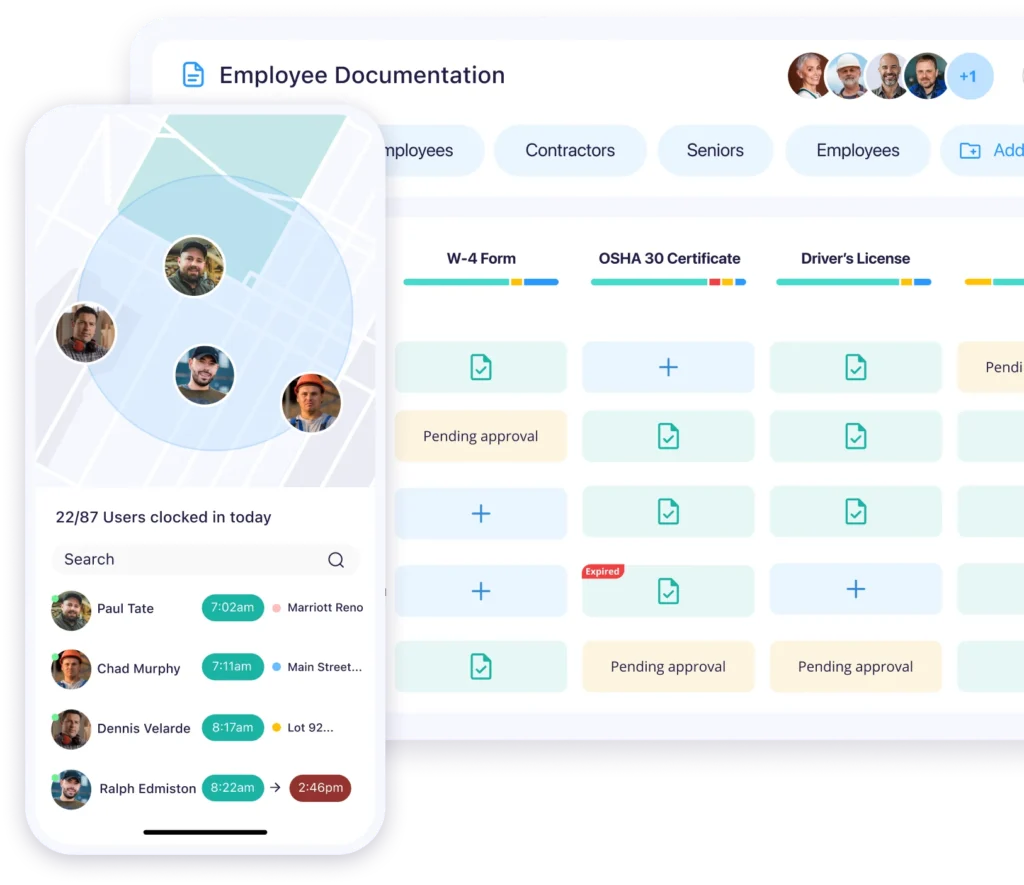
Connecteam ranks number one on my list of the best scheduling software for construction companies.
Why I chose Connecteam: I was impressed with everything from its clean and user-friendly mobile app to its AI-powered dispatching tools and top-notch customer support.
Let’s dive into Connecteam’s core scheduling features.
Smart scheduling with AI tools
Connecteam’s employee scheduler lets you create and assign shifts and schedules from scratch with drag-and-drop tools and ready templates, by copying previous schedules, or importing them from Excel.
Further, you can choose to create a master schedule across all job sites or individual schedules for each—a plus point from me in flexibility and customizability. And, you can build rest breaks and meal times right into schedules and set overtime rules and alerts to stay compliant with labor laws.
I think the best feature is Connecteam’s smart scheduler, which automatically assigns shifts to your crew based on their preferences, availability, qualifications, and location. Workers are happy to be assigned work that suits them, and you’re optimizing dispatching based on locations and skills—a win-win.
Additionally, I found it handy that Connecteam lets you allow workers to pick from open shifts or swap jobs with or without your approval (depending on your settings), taking away the headache of finding replacements when someone can’t make it to their shift.
Once dispatchers publish schedules, or if there are any shift changes, workers are notified instantly on their smartphones. They can also integrate Connecteam with their Google Calendars.
GPS time-clock
Connecteam’s time clock tracker allows your team members to punch in and out of their jobs from their individual smartphones, shared kiosks placed at job sites, or desktops if they’re office/admin employees.
In addition to time tracking, Connecteam also lets you monitor crew members’ live GPS locations and set geofences to prevent them from tracking time outside of their job sites. I think this is an excellent way to monitor that everyone is at their dispatch sites and prevent time theft, including buddy punching (where one worker punches in for another).
Integrated task management, forms, and checklists
With Connecteam’s employee task tracking feature, you can create and assign tasks and subtasks to your workers. Meanwhile, the digital forms and checklist tools help ensure employees conduct safety checks, submit incident reports, and more with e-signatures if required.
The best part? While these function as individual features, they’re also embedded within the scheduling tool. So, when you create a job/shift, you can add shift tasks and attach photos and notes, forms, and checklists, to ensure workers know exactly what’s expected of them as soon as they’re dispatched.
You can track task progress in real time, which is a great way to follow up, support workers where needed, and stick to project deadlines.
Leave management, work chat, document tracking, and so much more
With Connecteam’s time off management, workers can request leave, and you can respond to leave requests, all through the dashboard. This keeps you compliant, helps you provide workers with downtime, and also helps you plan schedules with your workers’ leave in mind.
Moreover, you can also store workers’ licenses and certifications in Connecteam’s team documents tool and get notified when they’re up for renewal, so you don’t dispatch unlicensed workers to job sites.
Finally, Connecteam also has an online team chat where you can discuss shifts, tasks, and more with your team in 1-to-1 or group settings. Plus, it offers many other operations, communication, and HR management features, making it an all-in-one construction collaboration software.
Key Features
- AI scheduling
- Open shifts and shift swapping
- Time and location tracking
- Integrated task management
- Digital forms and checklists
- Time off management
Pros
- Highly customizable
- Easy-to-use interface
- Mobile app—perfect for construction teams
- All-in-one job scheduling software for contractors and firms
Cons
- More integrations in development
Pricing
Free-for-life plan availablePremium plans start at $29/month for 30 users
14-day free trial, no credit card required
Start your free trial -

Workyard — Good for GPS time tracking and crew dispatching

Workyard is a workforce management tool designed for construction companies.
Why I chose Workyard: I like that Workyard offers key features like scheduling and time tracking plus offline functionality—a big plus when you’re constructing in low-coverage areas.
Here are Workyard’s main features.
Job scheduling
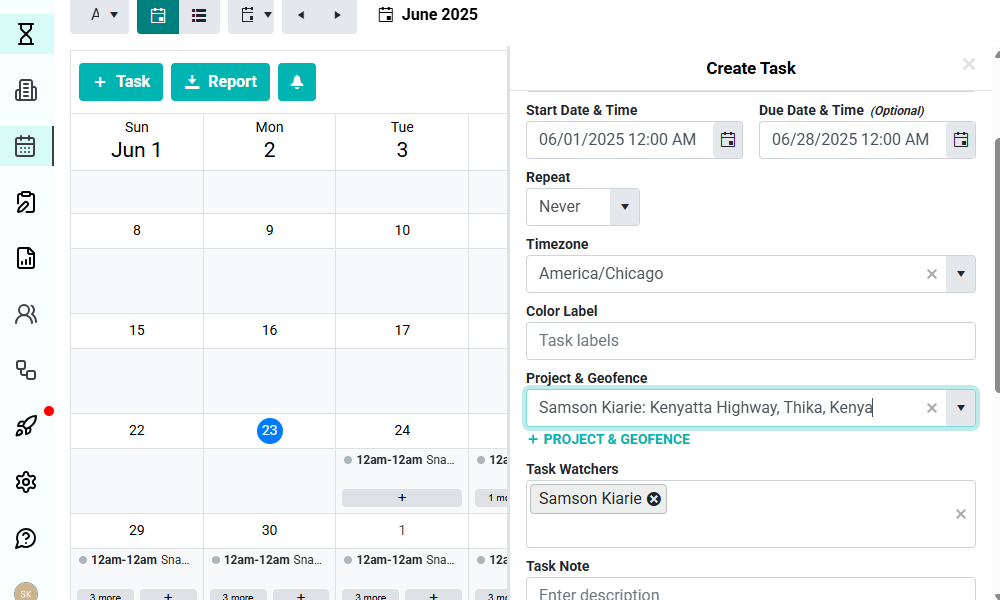
You can create a task and set it to recur with only a few clicks of a button. With Workyard, you can assign shifts or tasks using a color-coded scheduling interface for easy visibility. I like that you can create recurring shifts so you don’t need to recreate and reassign common duties every week. Each shift can be linked to projects, tasks (including recurring tasks), and even addresses and cost codes, so workers know where they need to go, what they need to do, and which cost center (department) to charge for supplies.
However, when we tested the platform, we found that the dispatching tools were fairly basic. For instance, there’s no AI scheduling, which increases both dispatchers’ workloads and the chances of them making scheduling errors that could lead to project delays and unhappy clients.
Time tracking and GPS functionality
Workyard lets employees clock in through their mobile devices or a shared kiosk, which I found helpful for adapting to different job site setups. I also liked the offline feature, which lets workers track hours without internet connectivity.
Workyard also offers GPS location tracking and geofencing to restrict clock-ins from outside of designated work zones.
Moreover, Workyard offers photo ID verification as an extra way to stop buddy punching.
Smart forms, integrations, and more
Workyard lets you create custom digital forms for safety inspections, material requests, and more. I liked that the platform offers an AI-powered editor to create and clone forms, and you can even have forms automatically appear at clock-in or clock-out, depending on your needs.
In addition, Workyard offers other tools like project management and time off management but it doesn’t include communication and HR management tools.
What users say about Workyard
I like the GPS tracking and how it works with gusto.
My experience has been fine although I wish it was a bit more hands off.
Key Features
- Shift scheduling
- Time clock
- GPS tracking
- Custom forms
Pros
- Offline functionality
- AI-powered smart forms
Cons
- No AI scheduling
- No communication or HR management tools
Pricing
Starts at $6 per user + $50 base fee Trial: No Free Plan: No
-
Fieldwire — Good for on-site task coordination
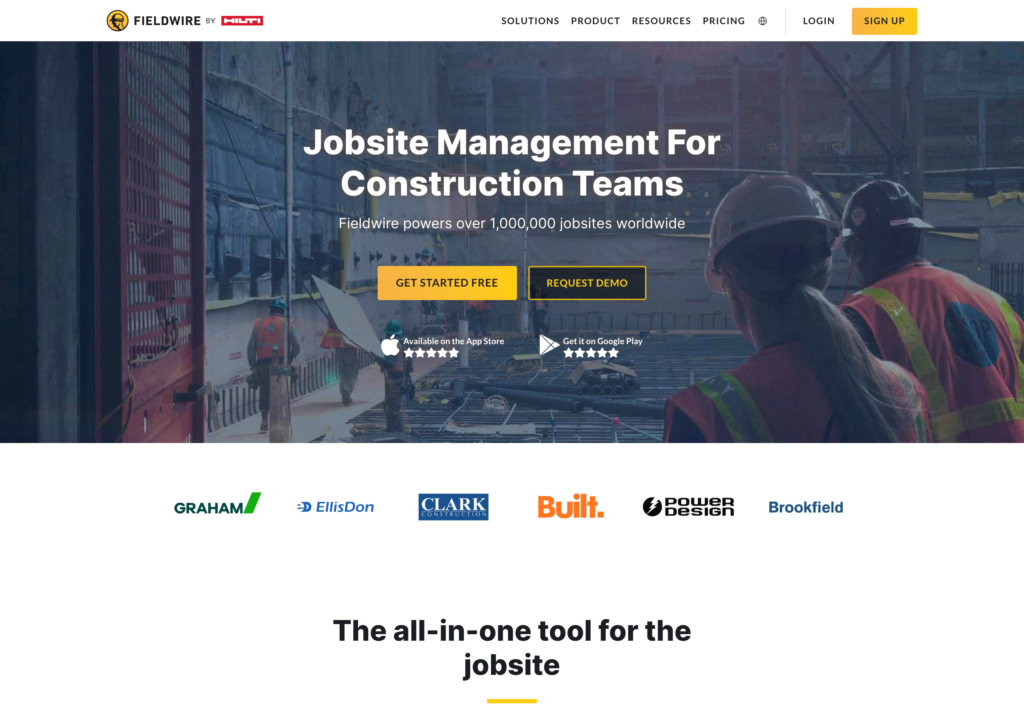
Fieldwire is a job site management platform with a range of construction project management tools.
Why I chose Fieldwire: I liked the platform’s task organization, change order workflows, and construction plan viewing features.
Below, I expand on these features.
Project and task management
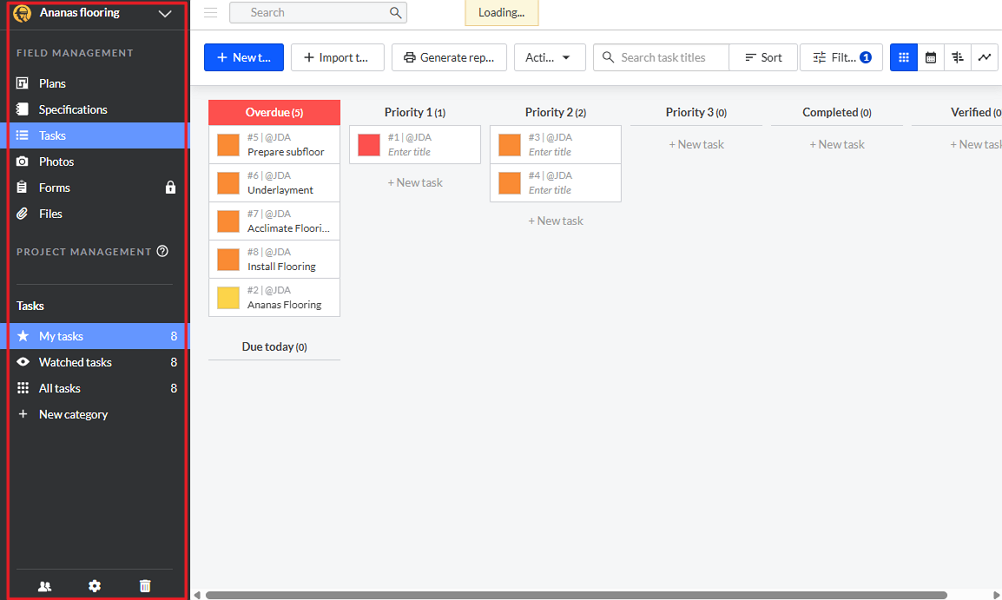
Each project on Fieldwire has its own menu and documents repository. With Fieldwire, you can create projects and break them into tasks and subtasks. The platform lets you assign these jobs or tasks to your workers and track them in Kanban, Calendar, or Gantt views.
I was also pleased to see the drag-and-drop functionality, which is useful for moving tasks around when there’s a change to on-site priorities or worker availability. When we tested Fieldwire, another feature that really stood out was the ability to set task priorities. This is great for ensuring your crew is focused on urgent or high-impact work first once you’ve dispatched them to their work sites.
Unfortunately, Fieldwire doesn’t offer smart scheduling, shift swapping, open shifts, or recurring templates. It also didn’t provide time tracking tools.
Additionally, its location tracking is built in a way that requires workers to submit photos or videos on the app, as it only tracks the coordinates of these instead of their live locations. This is unnecessarily complex and leaves room for errors like forgetting to log the content.
Plan viewing and communication
While construction employee scheduling software often lets you attach images and notes to employee tasks, Fieldwire takes this to the next level with its plan viewer. You can upload construction drawings directly, and the system automatically labels, categorizes, and names sheets using AI.
Change orders and RFIs
Fieldwire lets you create and track change orders, submittals, and RFIs on a central dashboard. This is effective for keeping communications structured and organized, and especially useful when project requirements change.
What users say about Fieldwire
Been using it on-site to keep track of what’s done and what’s left. It’s way better than chasing people around or trying to remember stuff from last week.
There are several tools missing that would give this tool much greater potential.
Key Features
- Project and task management
- Scheduling
- Plan viewing
- Change orders
Pros
- Advanced plan viewing and editing tools
- Ability to set task priorities
Cons
- Scheduling and dispatching capabilities are limited
- Lacks time tracking and other workforce management tools
Pricing
Starts at $39/user/month Trial: No Free Plan: Yes
-

Procore — Good for full-scale construction project management

Procore is a construction management platform for large teams.
Why I chose Procore: The platform has a comprehensive range of features, from time tracking and scheduling to drawing tools and in-app communications. While I think it’s more complex than what many smaller teams need, it could work well for larger enterprises.
Here are Procore’s key tools and features.
Employee scheduling and resource planning
The platform’s scheduling and resource planning tools let you drag and drop employees into shifts based on their skills and availability. In fact, it was easy to tag employees’ qualifications—a clever way to ensure they weren’t mistakenly scheduled for jobs out of their depth.
That said, while testing the app, we missed having scheduling templates or smart scheduling because this means you must create shifts from scratch every time. This can be tedious and frustrating for repetitive work.
Time tracking
Procore lets crew members log time from their mobile devices. They can also record breaks and link their hours worked to specific projects and departmental cost codes. While I appreciated how detailed the offering was, we found the process slightly cumbersome during testing, as it required multiple inputs before starting a shift or using the time clock.
I am, however, a fan of the platform’s geofencing capabilities and auto-reminders that nudge employees to clock in and out of the right locations.
Project and task management
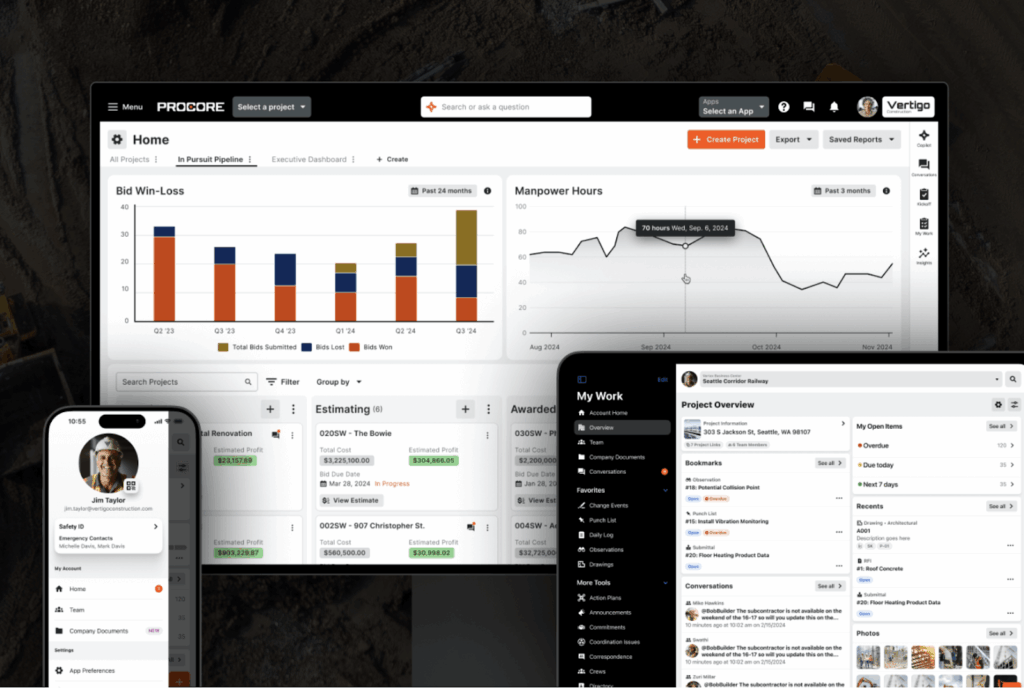
A graphic of Procore’s main login screen, as well as the main login screen of the mobile app, shown on both a phone and a tablet. With Procore, you can create projects, create tasks in them, and even upload drawings linked to them. There’s also a traffic light dashboard that lets you track project statuses, making it easier for dispatchers to prioritize what needs attention when they’re handling multiple job sites. Moreover, Procore also offers features that let you record incidents, run inspections, and create and assign corrective action from within the incidents feature.
Drawings and communication
Procore lets you upload and share drawings that auto-save the latest versions to avoid confusion. Dispatchers can tag issues directly on drawings and assign them as tasks, which I thought was impressive. Procore also offers an in-app chat for quick communication between crew members, managers, dispatchers, etc.
What users say about Procore
The user interface is intuitive, making it easy to collaborate with teams both in the office and in the field.
One of the biggest downsides of Procore is its complexity. The platform offers a staggering array of tools and features, many of which go unused by companies with more straightforward needs.
Key Features
- Employee scheduling
- Time tracking
- Project and task management
- Drawings and communication
Pros
- Ability to assign tasks from within drawings
- Traffic light system to prioritize projects
Cons
- No auto-scheduling or scheduling templates
- Complex user interface
Pricing
Contact vendor for price Trial: No Free Plan: No
-

Jobber — Good for service-based construction teams
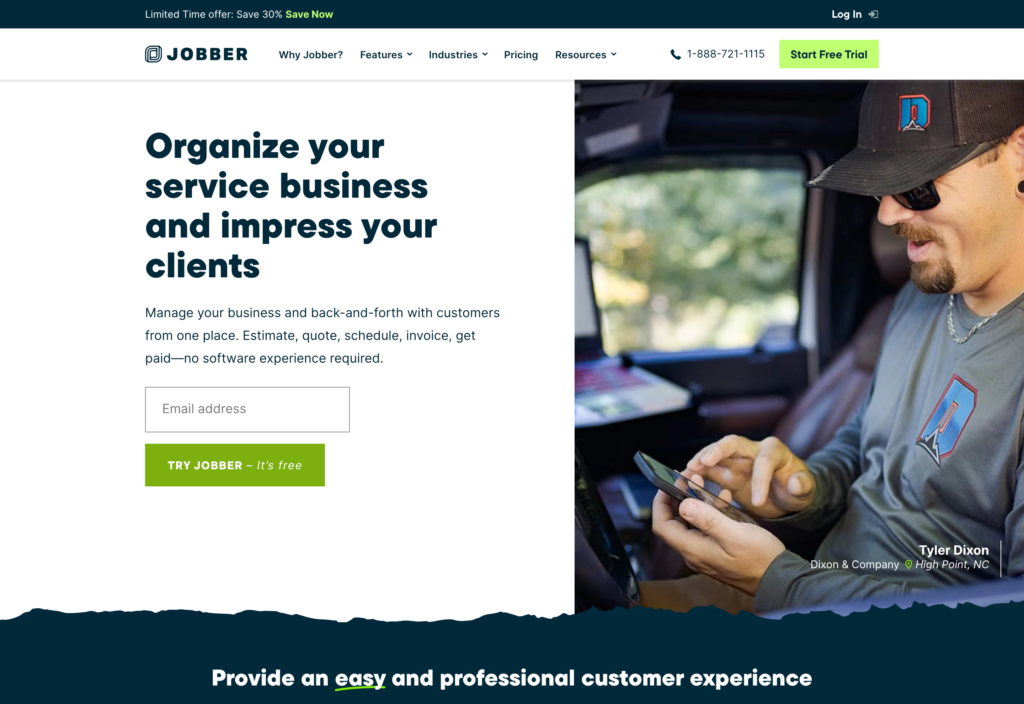
Jobber is a field service management tool for small to medium-sized teams.
Why I chose Jobber: The platform made it to my list of the best construction scheduling software because it simplified not only scheduling and dispatching but also client management.
Below, I describe Jobber’s key features.
Scheduling and dispatching
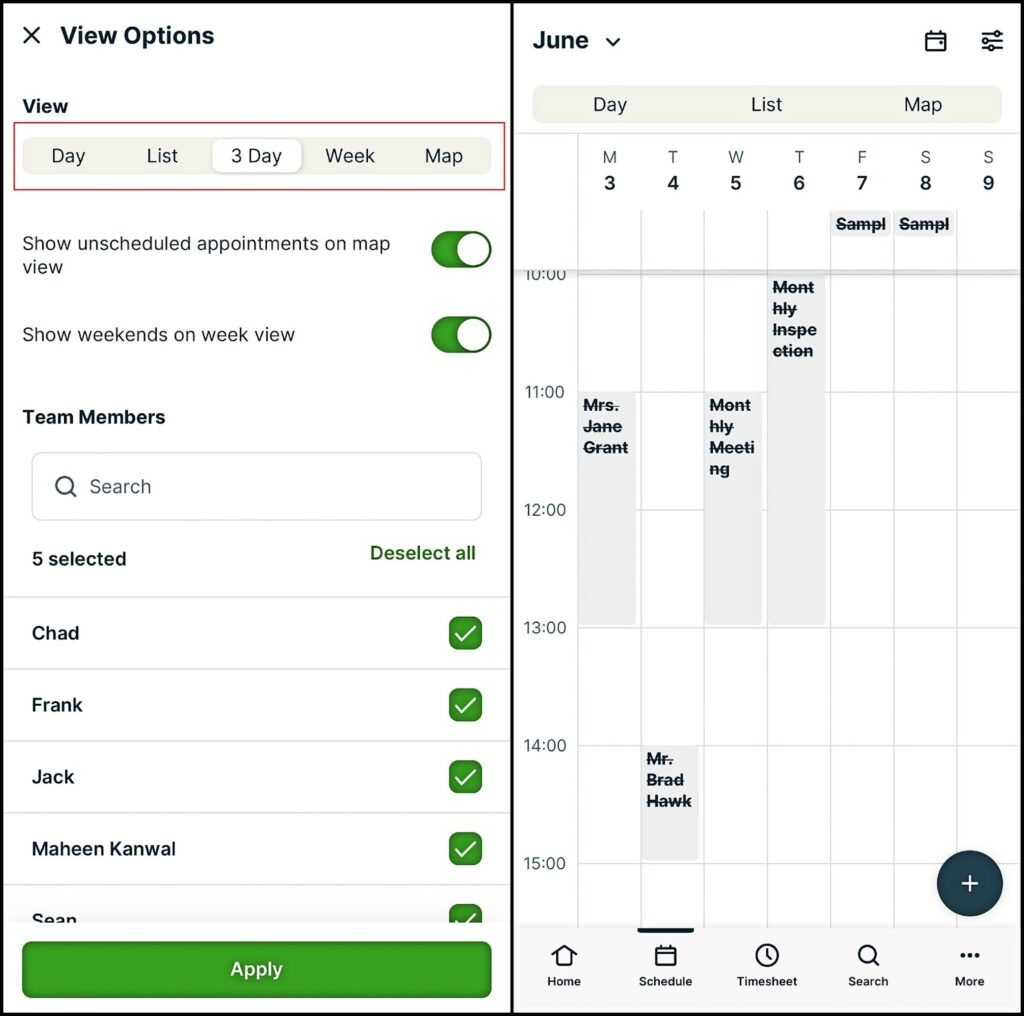
Jobber lets you create and assign jobs to team members. Similar to other software, Jobber offers drag-and-drop tools to quickly move things around and an intuitive color-coded system for seeing who’s assigned to which job and where.
What’s more, the platform offers an automatic route optimization tool, which updates routes when schedules change, so you can cut down on wasted time and fuel for workers traveling between job sites.
However, I wish it offered an auto-scheduling tool to reduce the hassle of assigning shifts manually.
During testing, we also noticed Jobber doesn’t offer time off management. Not being able to see employees’ vacation days when creating schedules can be problematic.
Time tracking and GPS functionality
With Jobber, crew members can clock in and out right from their mobile apps in a single tap and link their hours to the job. They can also log their hours manually if they forget.
Further, I liked that Jobber offered GPS tracking, making it easy to see if workers are on the sites they were dispatched to. But I was disappointed at the lack of geofencing capabilities and automatic overtime tracking.
Client management, invoicing, and more
On Jobber, every client has their own profile where you can access their service history, notes, upcoming jobs, and more. Clients can log in, see who’s scheduled and dispatched for jobs, and pay invoices online.
What users say about Jobber
Jobber has made scheduling for my team so much more seamless than a regular calendar.
Customer service has been unable to help due to limitations on the system. The employee info it keeps track of is very basic. For instance I can not mark employees out for vacation on the schedule.
Key Features
- Job scheduling
- Time tracking
- Client management
- Payments and invoicing
Pros
- Strong client management capabilities
- Automatic route optimization
Cons
- No auto-scheduling
- Lacks time off management
Pricing
Starts at $29/month, for 1 user only Trial: Yes — 14 days Free Plan: No
The 5 Best Dispatch Software for Construction Projects in 2025
| Topic |
 Start for free
Start for free
|

|
|

|

|
|---|---|---|---|---|---|
| Reviews |
4.8
|
4.7
|
4.6
|
4.5
|
4.5
|
| Pricing |
Starts at just $29/month for the first 30 users
|
Starts at $6 per user + $50 base fee
|
Starts at $39/user/month
|
Contact vendor for price
|
Starts at $29/month, for 1 user only
|
| Free Trial |
yes
14-day
|
no
|
no
|
no
|
yes
14 days
|
| Free Plan |
yes
Free Up to 10 users
|
no
|
yes
|
no
|
no
|
| Use cases |
Best all-in-one construction dispatch software
|
Good for GPS time tracking and crew dispatching
|
Good for on-site task coordination
|
Good for full-scale construction project management
|
Good for service-based construction teams
|
| Available on |
What Is Construction Dispatch Software?
Construction job scheduling software is a set of digital tools that helps construction firms manage and track their crews’ jobs, schedules, and workloads efficiently.
The dispatching tools on these platforms let you create and assign jobs with easy drag-and-drop tools or AI automation, and notify workers about jobs instantly on their smartphones.
How Does Dispatch Software for Construction Work?
Managers use construction dispatch software like a control center. At the start of the day or week, you can log in to your dashboard, create shifts, build tasks, forms, and checklists into them, and assign them to team members. Once workers head to their job sites, you can track their hours, locations, and job progress, and make quick adjustments if needed.
For workers, the software feels more like a personal to-do list available on their smartphones. They can start the day by checking in and viewing their assigned jobs and locations. When they get to their job sites, they log their hours, complete any required forms and checklists, upload photos, and more right in their apps before clocking out for the day.
The Benefits of Construction Dispatch Software
Here are the benefits of using dispatch software in construction.
Reduces administrative load
Dispatch software simplifies and automates tasks like assigning jobs, tracking time, optimizing routes, and more. This means less time and energy spent on manual scheduling, paperwork, and endless back-and-forth.
Improves internal communication and eliminates mistakes
Dispatchers can send clear information about where workers need to be, what they need to do, and when. This cuts down misunderstandings and ensures everyone is aligned.
Prevents project delays
With the right dispatching software, you no longer have to chase workers for updates, such as whether they’ve reached their job sites on time and completed their tasks.
You can see the status of every task and even request signed forms and checklists, making it easier to spot missed tasks or delays and keep projects moving forward.
Boosts customer satisfaction
When teams arrive on time, complete jobs properly, and share accurate updates, clients take note. Dispatch software helps deliver an impressive customer experience, which can ultimately lead to repeat business and more revenue.
Supports compliance
Construction companies must meet strict health and safety regulations. Dispatch software makes it easier to document work, store digital records of incidents and safety checks, and prove compliance with these regulations—essential for avoiding hefty penalties.
How Much Does Construction Dispatch Software Cost?
Construction dispatch solutions vary a lot in pricing and pricing models. For example, Workyard’s Pro plan, which includes scheduling, starts at $13/user/month and also has a $50/month base fee. Jobber charges $29/user/month on its core plan but this doesn’t offer time tracking. Both plans can get expensive very quickly as construction companies grow and scale.
I think Connecteam offers the best value for money. It starts at just $29/month for up to 30 users, and $0.50 for every additional user. It also offers a free plan for small businesses and a free 14-day trial, making it especially great for construction businesses just starting out.
FAQs
Connecteam is the best construction management platform. It offers a wide range of tools, from dispatching, time tracking, task management, and compliance support, to license and certification tracking, safety training, internal communications, and more.
Today, you can use AI tools like ChatGPT to help you calculate construction costs. The key, however, is to input the right prompts. For this you need to know what items you’ll need to spend money on—from labor to marketing, and more.
Connecteam is among the best construction apps with AI tools. It auto-builds schedules based on company and worker preferences, turns files into digital forms, creates training courses, auto-translates them into employees’ preferred languages, and so much more.
The Bottom Line on Dispatch Software for Construction
Construction dispatching platforms take the stress out of managing teams, shifts, and projects.
After conducting a top construction dispatch software comparison, I find Connecteam to be the most complete and cost-effective solution. With AI-powered scheduling, GPS time tracking, task management, and so much more, it’s built to handle real-world construction needs and set you up for success.


